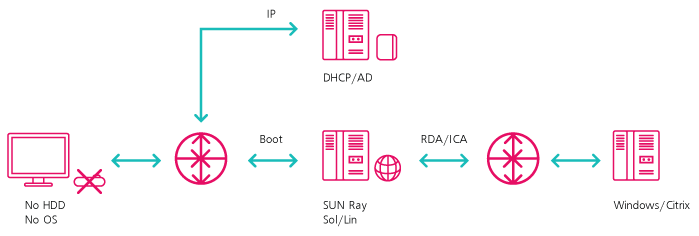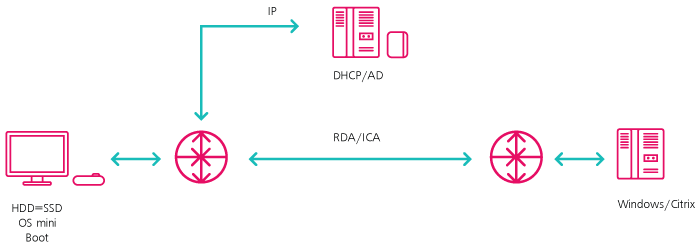Thin Clients
At the first glance the task of provision of users with necessary computing resources at working stations seems rather simple. However large number of users complicates this work due to difficulties of work station infrastructure update and the infrastructure support.
At the same time almost every necessity of IT infrastructure update (in particular, connected with increase of the number of users) can face workaday but almost insuperable obstacles connected to insufficient space to install new hardware or absence of required electric capacity.
Thin client and virtualization technologies offered by Open Technologies allow optimization of provision of users with required computing resources and significant increase of IT infrastructure efficiency, among them reduction of requirements to premises and engineering systems.
Conventional approach to creation (updating) of worksites
Conventional approach to creation of worksite can have certain problems. Let's regard two of them separately - problem of organization of automated worksites and problem of Data Processing Center operation.
Automated work stations
The user worksites are equipped with full-fledged work stations with hard discs, operation system, various adapters, etc. Disadvantages of this approach:
- heterogeneous PCs at worksites;
- user's attachment to worksite;
- fast PC depreciation;
- low PC reliability;
- low security level;
- difficult to ensure backup;
- difficult to administrate;
- license policy.
As a result - unreasonably high parameters of the total cost of ownership of the automated worksite system, low system performance from the point of view of information security, low availability of corporate services for employees.
Data Processing Center
The data processing center (or server room) includes several various servers, data storage devices and switches. Users work with resources of servers and repositories.
Application of new technologies in creation (updating) of new workstations
Conventionally, with growth of the number of workstations the scaling is ensured by growth of equipment number (horizontal scaling). With strict limits of resources consumed, the horizontal scaling of computing complexes becomes almost impossible: high cost of the complex administration, high cost of power supply, etc. And even in this case all server capacities are not enough to satisfy the enterprise needs.
Automated work stations
Problems of conventional approach to organization of automated work stations can be solved by application of thin (or terminal) client technology.
The user workstation will be equipped only with hardware able to transmit signals from the user workstations and display desktop or application window image transmitted by the server. No data are stored at the workstation, no application works. Everything is stored at the protected server. In case of the worksite device failure it can be either replaced within several minutes without additional adjustments or the user can sit at any other free worksite and continue his/her work from the interrupted moment. Thus, the data and possibility to access services is preserved.
There are two main schemes of worksite connection:
Scheme 1. Worksite is an ultrathin client represented by disc-free terminal. Ultrathin client receives IP address either from DHCP/AD or defined in ePROM. All downloads are from the load pattern server (at the figure - SUN Ray as an example). After that connection to terminal server occurs, followed by connection via RDP to Windows Terminal Server or via ICA to Citrix.

Figure 1. Connection via terminal server.
Scheme 2. Workstation is a thin client with hard disc (as a rule, flash memory) with operation system with minimum requirements to ensure downloads and establish connection. The thin client receives IP address either from DHCP/AD or defined in operation system settings. After that connection is established via RDP directly to Windows Terminal Server or via ICA to Citrix.

Figure 2. Connection via RPD/ICA.
Data Processing Center
It is possible to cut expenses of server operation including energy consumption costs using virtualization technology. Joining several servers under one "iron roof" you get the following advantages:
- separation of operation system and equipment - no more dependency on hardware;
- control of operation system and applications as a unity via encapsulation into virtual engines;
- full isolation from the point of view of safety and fail-safety;
- standard and independent environments can be supplied any time;
- flexibility when choosing necessary operation system for every application.
Thus we see that, stepping away from conventional approach, one can reduce expenses of:
- administration: thin clients are maintained by fewer engineers. A set of virtual machines ensuring the same volume of services is easier to operate than the same number of physical servers;
- energy supply: thin clients and servers with virtual engines consume less power;
- payments for premises: thin clients and servers with virtual machines occupy less space.
Open Technologies can offer creation and testing of various solutions at the stand created on the basis of thin clients and virtualization technologies taking into account specific traits and needs of your organization.
Open Technologies is a certified partner of the leading hardware manufacturers. Our service package includes pre-design inspection, technical solution designing and testing, installation and execution of acceptance tests, integration with existing information infrastructure, as well as technical support and monitoring - the whole range of services to provide optimal and continuous work of the IT systems.
Our advantages:
- customized designing;
- special attention to information protection of the solution;
- possibility to construct solution of any difficulty and performance;
- execution of the whole range of works (technical solution development, designing of technological solution, hardware and software supplies, installation and construction works, commissioning, organization of required infrastructure);
- trainings for the customer specialists to work with solution created;
- advanced support of installed solution (including outsourcing);
- availability of certificates and licenses required for the work;
- high partner statuses of the leading hardware and software manufacturers, including producers of thin clients and virtualization technologies;
- regional representative office chain.








